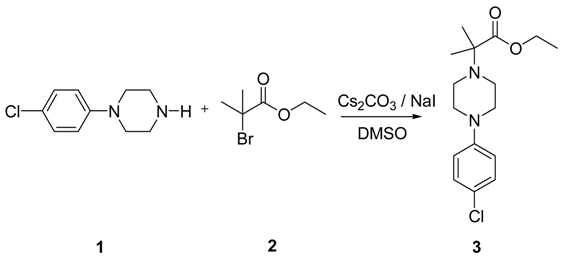Abstract
The title compound was synthesized by N-alkylation of 4-(4-chlorophenyl)piperazine with ethyl 2-bromo-2-methylpropanoate and its IR, 1H NMR, 13C NMR and Mass spectroscopic data are reported.
One of the principal interests of our research group is to design and synthesize candidate cytotoxins based on the α,β-unsaturated keto scaffolds [1,2,3]. A number of these molecules have been shown to alkylate thiols but not amino or hydroxy substituents. Since thiols, in contrast to amino or hydroxyl groups are not found in nucleic acids, α,β-unsaturated ketones are bereft of the carcinogenic and mutagenic properties displayed by various anticancer drugs [4]. A series of compounds, including the title compound 2-[4-(4-chlorophenyl)-piperazin-1-yl]-2-methylpropanoic acid ethyl ester (3) were prepared for the construction of somewhat complex molecules containing α,β-unsaturated keto scaffold. The title compound was prepared by the route depicted in the scheme below.
To a solution of 4-(4-chlorophenyl)piperazine dihydrochloride 1 (5.0 g, 0.0185 mol) in DMSO (30 ml), anhydrous cesium carbonate (30.0 g, 0.0925 mol), sodium iodide (1.39 g, 0.0093 mol) and ethyl 2-bromo-2-methylpropanoate 2 (3.97 g, 0.02 mol) were added. The resulting mixture was stirred at 25-30oC for 12 hours. The reaction mass was diluted with water (200 ml) and extracted with ethyl acetate (2 x 200 ml). The ethyl acetate layer was washed with water (2 x 100 ml), dried over anhydrous sodium sulfate (10.0 g) and concentrated under vacuum. The crude product thus obtained was purified by column chromatography (stationary phase silica gel 60-120 mesh; mobile phase 10% ethyl acetate in hexane). The title compound 3 was obtained as a white solid (4.73 g, 82 %).


Melting Point: 56oC.
EI-MS m/z (rel. int. %): 311 (100) [M+1]+, 236(40), 197(60), 154(45).
IR ν max (KBr) cm-1: 2839-2996 (C-H aliphatic); 1728 (C=O), 1595, 1505 (C=C aromatic), 1205 (C-O bending), 758 (C-Cl bending).
1H NMR (400 MHz, CDCl3): δ ppm 1.27 (t, 3H, J = 7.2 Hz, -CH2-CH3), 1.35 (s, 6H, 2 x CH3), 2.74-2.76 (m, 4H, J = 4.8 Hz, -CH2-N-CH2-), 3.14-3.17 (m, 4H, J = 4.8 Hz, -CH2-N-CH2-), 4.20 (q, 2H, J = 7.2 Hz, -CH2-CH3), 6.81-6.83 (d, 2H, J = 6.8 Hz, phenyl protons), 7.17-7.20 (d, 2H, J = 6.8 Hz, phenyl protons).
13C NMR (100 MHz, CDCl3): δ ppm 14.3 (CH3), 22.7 ((CH3)2), 46.6 (-CH2-N-CH2-), 49.7 (-CH2-N-CH2-), 60.5 (O-CH2), 62.4 (N-C-), 117.0, 124.3, 128.8, 149.8 (aromatic carbons), 174.3 (C=O).
Elemental analysis: Calculated for C16H23ClN2O2: C, 61.83%, H, 7.46%, N, 9.01%; Found: C, 61.90%, H, 7.44%, N, 8.98%.
Supplementary materials
Supplementary File 1Supplementary File 2Supplementary File 3Acknowledgements
We sincerely thank Department of Chemistry, Sambalpur University for providing the facility and support.
References
- Pati, H.N.; Das, U.; Clercq, E.D.; Balzarini, J.; Dimmock, J.R. Molecular modifications of 2-arylidene-1-indanones leading to increased cytotoxic potencies. J. Enz. Inhib. Med. Chem. 2007, 22, 37–42. [Google Scholar] [CrossRef] [PubMed]
- Pati, H.N.; Das, U.; Ramirez-Erosa, I.J.; Dunlop, D.M.; Hickie, R.A.; Dimmock, J.R. α,β-Substituted 1-aryl-3-dimethylaminopropanone hydrochlorides: potent cytotoxins towards human WiDr colon cancer cells. Chem. Pharm. Bull. 2007, 55, 511–515. [Google Scholar] [CrossRef] [PubMed]
- Pati, H.N.; Das, U.; Das, S.; Bandy, B.; Clercq, E.D.; Balzarini, J.; Kawase, M.; Sakagami, H.; Quail, J.W.; Stables, J.P.; Dimmock, J.R. The cytotoxic properties and preferential toxicity to tumor cells displayed by some 2,4-bis(benzylidene)- 8- methyl-8-azabicyclo[3.2.1]octan-3-ones and 3,5-bis(benzylidene)-1-methyl-4-piperidones. Euro. J. Med. Chem. 2009, 44, 54–62. [Google Scholar] [CrossRef] [PubMed]
- Pati, H.N.; Das, U.; Sharma, R.K.; Dimmock, J.R. Cytotoxic thiol alkylators. Mini-Rev. Med. Chem. 2007, 7, 131–139. [Google Scholar] [CrossRef] [PubMed]
© 2009 by the authors; licensee Molecular Diversity Preservation International, Basel, Switzerland. This article is an open-access article distributed under the terms and conditions of the Creative Commons Attribution license (http://creativecommons.org/licenses/by/3.0/).